View the full Brand Finance Food & Drink 2021 report here
The majority of the subsectors included in the Brand Finance Food & Drink 2021 report have recorded cumulative brand value losses this year, as the sector negotiates the fallout from the COVID-19 pandemic. Soft drink brands are the most severely impacted, with the total value of the world’s top 25 most valuable soft drinks brands declining by 6%, from US$114.8 billion in 2020 to US$107.5 billion in 2021. The total brand value of food and chocolate brands have declined by 4% and 3%, respectively. The only subsector in the report to protect itself from a brand value loss is the dairy sector, which has maintained its total brand value year-on-year.
Savio D’Souza, Valuation Director, Brand Finance commented:
“The COVID-19 pandemic has put a huge amount of pressure on the food & drink industry globally, from disrupted supply chains and panic buying, to a complete change in consumer habits. The result of this has led to the majority of brand values suffering this year across the sector. The future is not bleak, however, brands with high levels of familiarity and reputation are likely to bounce back successfully as we begin the return to normality.”
Always Coca-Cola: brand tops soft drink ranking
American giant, Coca-Cola, has once again been named the world’s most valuable soft drink brand, despite recording a 13% brand value decline to US$33.2 billion. Coca-Cola maintains a healthy lead over rival Pepsi, sitting in 2nd place with a brand value of US$18.4 billion.
In addition to measuring overall brand value, Brand Finance also determines the relative strength of brands through a balanced scorecard of metrics evaluating marketing investment, stakeholder equity, and business performance. According to these criteria, Coca-Cola is also the world’s strongest soft drink brand – and the 4th strongest brand in the world according to the Brand Finance Global 500 2021 ranking - with a Brand Strength Index (BSI) score of 91.7 out of 100 and a corresponding elite AAA+ brand strength rating.
With a rich 129-year long history, Coca-Cola is still the most consumed soda in the world, with a staggering 1.9 billion servings, across 200 countries, enjoyed each day. As with other brands globally, however, the brand’s parent company has not been immune to the impact of COVID-19, with the multinational forced to restructure and cut over 2000 jobs.
Coca-Cola continues to strive towards its CSR responsibilities, recently announcing its partnership with The Ocean Cleanup’s River Project, where it will utilise its global network to tackle the amount of plastic entering the oceans. This is just the latest prong in the company’s wider vision for a “World Without Waste”.
When looking at the brand portfolios across the food & drink sector, The Coca-Cola Company’s portfolio claims third position with a cumulative brand value of US$48.6 billion. PepsiCo’s portfolio sits in second, with a total brand value of US$59.3 billion.
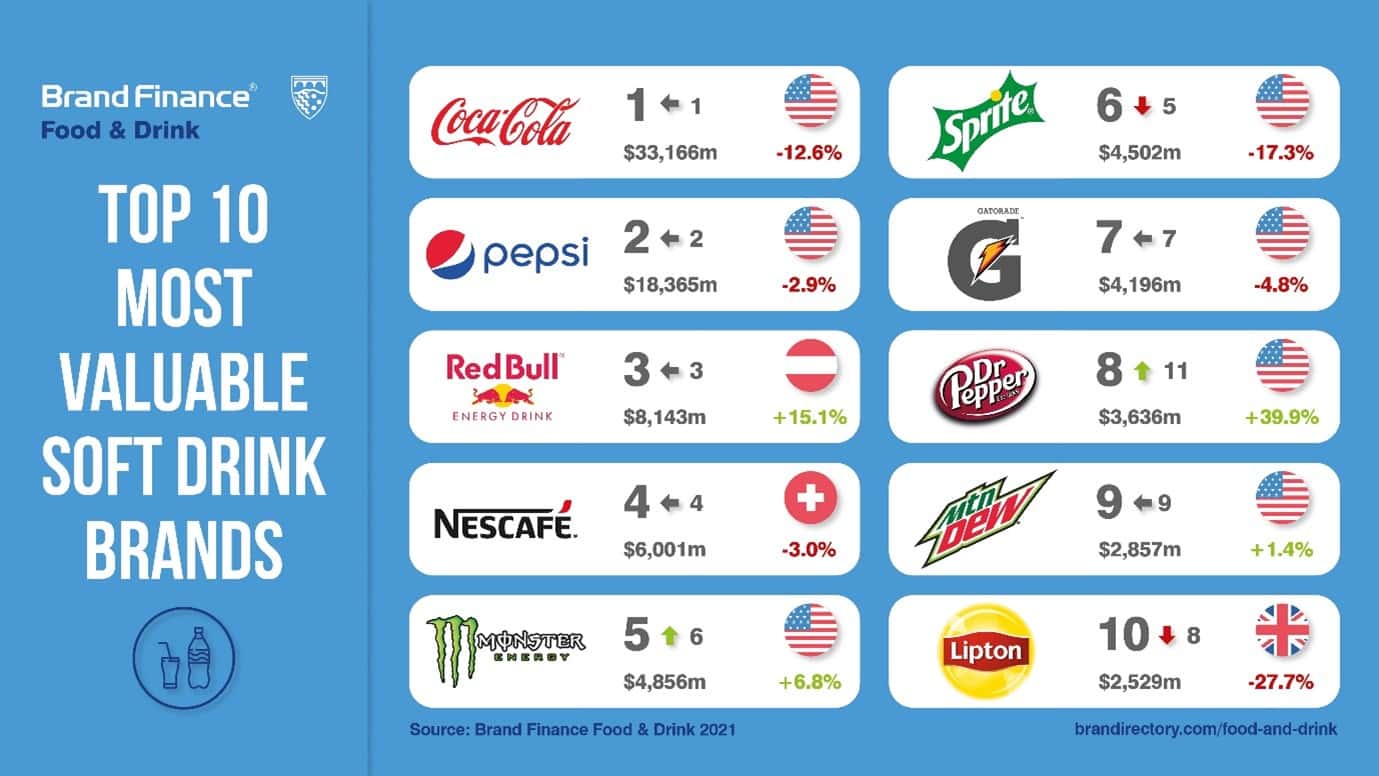
Dr Pepper and Red Bull bubble up
Dr Pepper and Red Bull are the fastest and second-fastest growing soft drink brands this year, recording a 40% and 15% brand value increase, respectively.
Entering the top 10, jumping from 11th to 8th this year, is Dr Pepper. Dr Pepper has celebrated increased popularity and sales over the previous several years and demand grew exponentially last year as American consumers took to ‘pantry-loading’ amid the panic-buying phase of the pandemic.
Founded in 1987, Austria’s Red Bull is known for its unique marketing strategy which embraces extreme sports, celebrity endorsements, music, and more – an approach which sets the brand apart when it comes to connecting with consumers. This presence, paired with nearly eight billion units sold of the drink in 2020 alone, has enabled the brand to grab the bull by the horns and solidify its third position in the Brand Finance Soft Drinks 50 2021 ranking.
Nestlé dominates food sector
Nestlé (brand value US$19.4 billion; BSI score 86.4 out of 100) once again leads the pack as the world’s most valuable and strongest brand in the Brand Finance Food ranking, which for the first time has been extended to 100 brands.
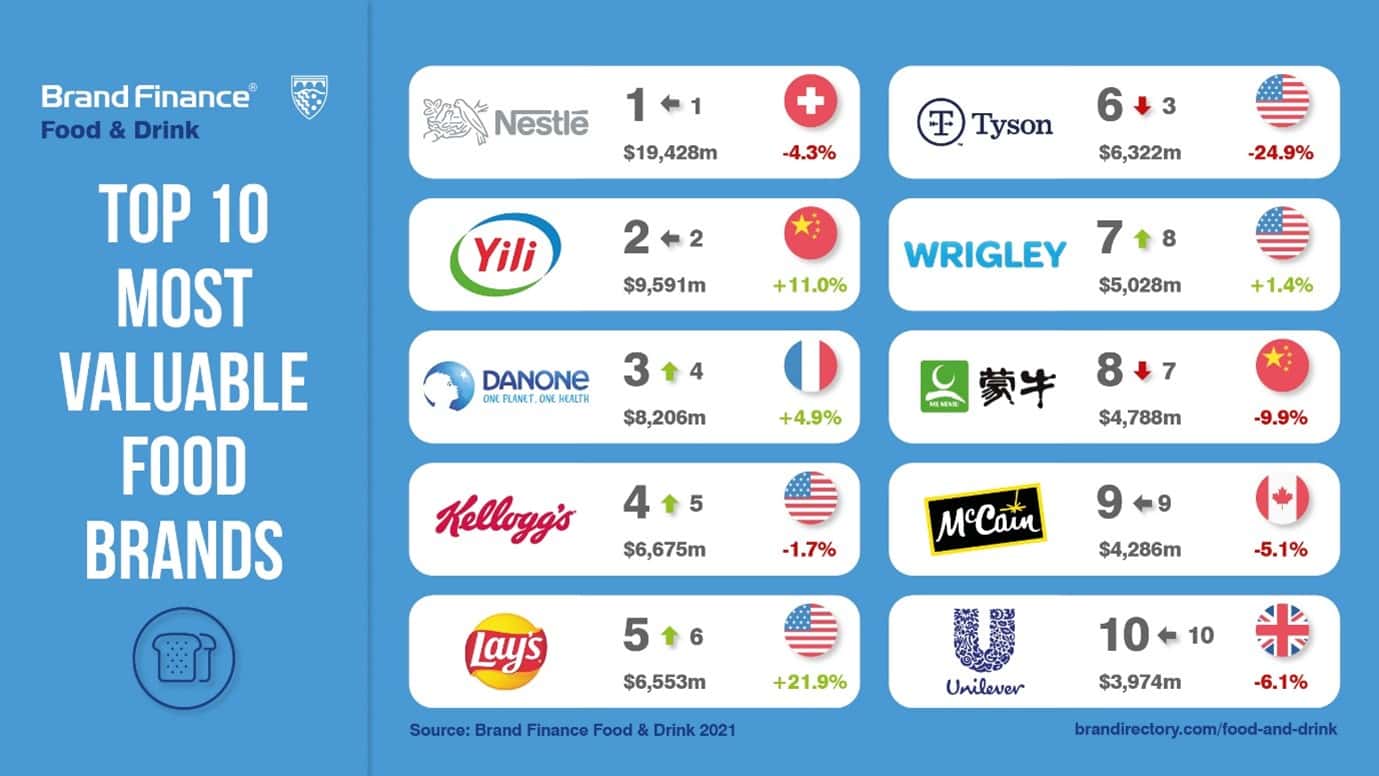
Despite the pandemic, the food giant has posted its third consecutive year of organic growth, profitability, and return on investment capital. The sheer size, presence, and experience of the company in the sector has allowed it to successfully adapt to the ever-changing and challenging landscape.
According to Brand Finance’s Global Brand Equity Monitor, Nestlé has increased its scores in the consideration metric, as well as improving its score for the community and environment metrics under the CSR measurement. With a continued focus on product innovation and R&D, Nestlé is spearheading changes to reflect the current consumer trends, from its product Smarties becoming the first major global confectionary brand to switch to recyclable paper packing, to announcing the launch of a vegan KitKat.
The Nestlé portfolio is also the most valuable food & drink portfolio, with a total brand value of US$65.6 billion. Despite the parent company underperforming compared with the previous year, it has been offset by the overperformance of some of its sub brands, particularly in the pet care and non-alcoholic drinks segments.
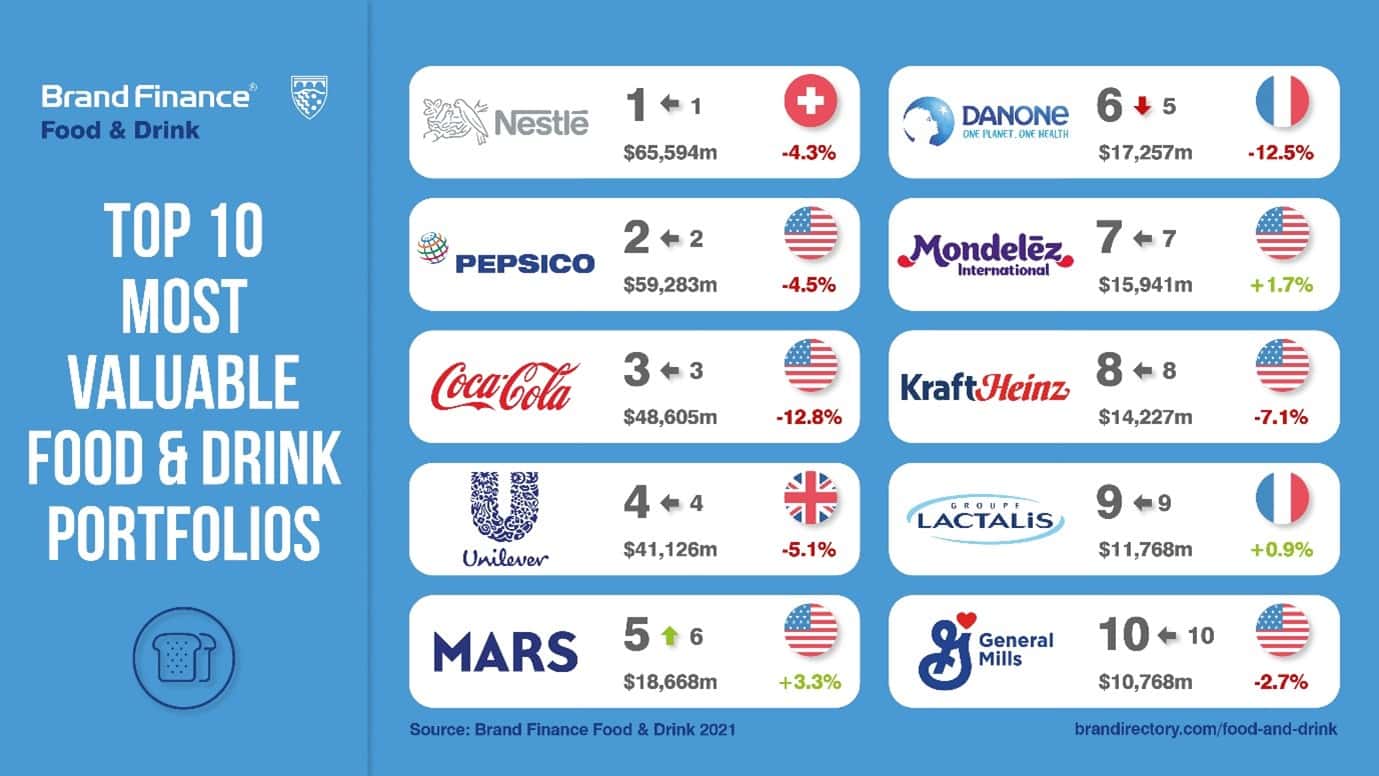
Yili posts healthy growth
Once again, Yili is the world’s most valuable dairy brand, posting an 11% increase in brand value this year to US$9.6 billion and pulling even further ahead of previous sector leader Danone (up 5% to US$8.2 billion) in second place. Yili also claims second spot behind Nestlé in the Brand Finance Food 100 2021 ranking.
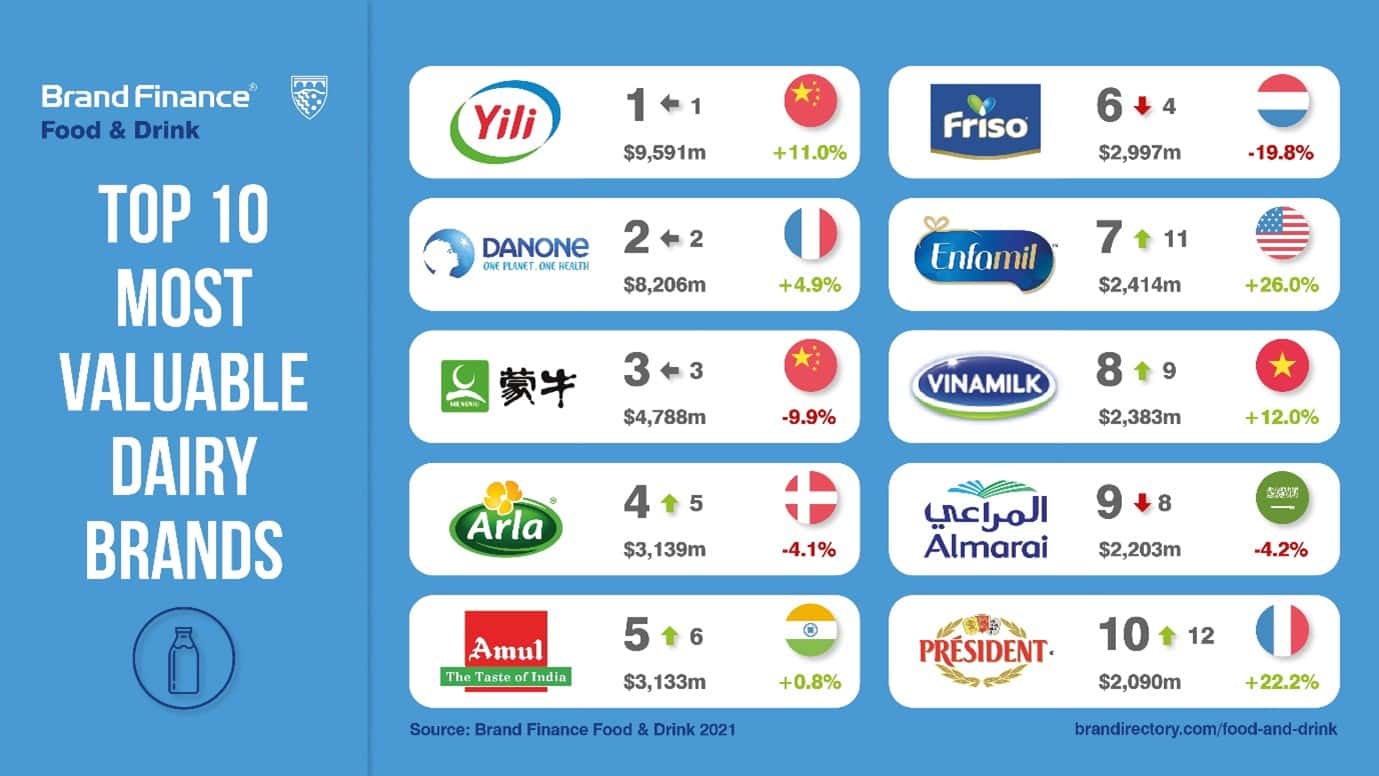
Despite the pandemic turmoil of the previous year, Yili has boasted strong sales growth, up 13% year-on-year, and the long-term forecast for the brand looks positive. The dairy giant has once again been striving towards new products and optimisation, bolstered by innovation and long-standing R&D investment. This, paired with further expansion into new territories across Asia and overseas, has supported the brand’s strong growth.
According to Brand Finance’s Global Brand Equity Monitor, Yili scores very high for consideration compared to its peers. These solid results could be due to the brand’s focus on raising brand awareness, most notably through the sponsorship of the 2008 Beijing Olympics. Fellow Chinese dairy brand, Mengniu (down 10% to US$4.8 billion), has been implementing a similar strategy, previously sponsoring the 2018 FIFA World Cup, and more recently, signing the first-ever joint worldwide ‘TOP’ Partner agreement with the International Olympic Committee together with The Coca-Cola Company, that will continue until the 2032 Olympics.
The Brand Finance Food & Drink 2021 report also includes the Dairy Portfolio ranking – which splits the brand value related to dairy brands from the wider food portfolios – as dairy brands represent a large proportion of the food portfolios’ brand value and often are responsible for movement within the overall ranking.
Yili has the fourth most valuable dairy portfolio, with a total brand value of US$9.6 billion, an impressive performance given that Asian dairy brands have traditionally been outperformed by their international counterparts. Lactalis has overtaken last year’s leader, Nestlé, with a combined brand value of US$11.4 billion.
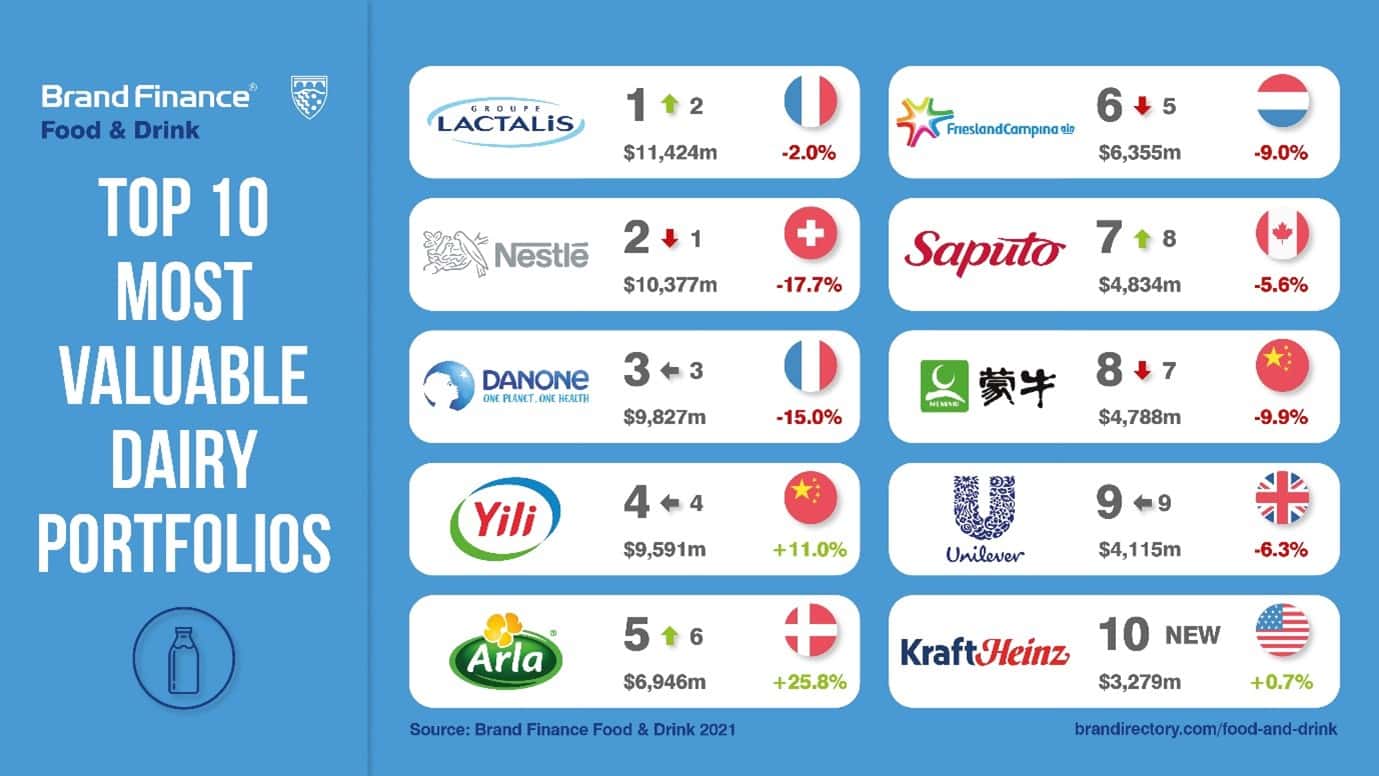
Lindt hops to the top of the chocolate ranking
A market leader in premium quality chocolate, Lindt, is the world’s most valuable chocolate brand, recording an impressive 21% brand value increase to US$3.1 billion. As with other chocolate brands globally, Lindt’s operations have taken a hit amid global lockdowns, particularly from those that have taken place over Easter and Christmas. That being said, Lindt has outperformed its peers, gaining market share in nearly all of its markets and posting strong results in the premium segments.
Cadbury’s is the only other chocolate brand to record a brand value increase this year, up 5% to US$2.5 billion. Owned by Mondelēz International and sold in over 30 countries - with its top three markets the UK, Australia, and India - Cadbury’s has reaped the benefits of increased spending on its products during the pandemic. Towards the end of 2020, spending on chocolate in the UK soared by £50 million year-on-year as millions comfort ate at home.
View the full Brand Finance Food & Drink 2021 report here
ENDS
Note to Editors
Every year, Brand Finance puts 5,000 of the biggest brands to the test, evaluating their strength and quantifying their value, and publishes nearly 100 reports, ranking brands across all sectors and countries. The 25 most valuable soft drink brands, the 100 most valuable food brands, 10 most valuable dairy brands, and 5 most valuable chocolate brands are included in the Brand Finance Food & Drink 2021 report.
The full rankings, additional insights, charts, more information about the methodology, as well as definitions of key terms are in the Brand Finance Food & Drink 2021 report.
Brand value is understood as the net economic benefit that a brand owner would achieve by licensing the brand in the open market. Brand strength is the efficacy of a brand’s performance on intangible measures relative to its competitors. Please see below for a full explanation of our methodology.
About Brand Finance
Brand Finance is the world’s leading brand valuation consultancy. Bridging the gap between marketing and finance, Brand Finance evaluates the strength of brands and quantifies their financial value to help organisations of all kinds make strategic decisions.
Headquartered in London, Brand Finance has offices in over 20 countries, offering services on all continents. Every year, Brand Finance conducts more than 5,000 brand valuations, supported by original market research, and publishes nearly 100 reports which rank brands across all sectors and countries.
Brand Finance is a regulated accountancy firm, leading the standardisation of the brand valuation industry. Brand Finance was the first to be certified by independent auditors as compliant with both ISO 10668 and ISO 20671, and has received the official endorsement of the Marketing Accountability Standards Board (MASB) in the United States.
Methodology
Definition of Brand
Brand is defined as a marketing-related intangible asset including, but not limited to, names, terms, signs, symbols, logos, and designs, intended to identify goods, services, or entities, creating distinctive images and associations in the minds of stakeholders, thereby generating economic benefits.
Brand Value
Brand value refers to the present value of earnings specifically related to brand reputation. Organisations own and control these earnings by owning trademark rights.
All brand valuation methodologies are essentially trying to identify this, although the approach and assumptions differ. As a result, published brand values can be different.
These differences are similar to the way equity analysts provide business valuations that are different to one another. The only way you find out the “real” value is by looking at what people really pay.
As a result, Brand Finance always incorporates a review of what users of brands actually pay for the use of brands in the form of brand royalty agreements, which are found in more or less every sector in the world.
This is known as the “Royalty Relief” methodology and is by far the most widely used approach for brand valuations since it is grounded in reality.
It is the basis for our public rankings but we always augment it with a real understanding of people’s perceptions and their effects on demand – from our database of market research on over 3000 brands in over 30 markets.
Brand Valuation Methodology
For our rankings, Brand Finance uses the simplest method possible to help readers understand, gain trust in, and actively use brand valuations.
Brand Finance calculates the values of brands in its rankings using the Royalty Relief approach – a brand valuation method compliant with the industry standards set in ISO 10668.
Our Brand Strength Index assessment, a balanced scorecard of brand-related measures, is also compliant with international standards (ISO 20671) and operates as a predictive tool of future brand value changes and a control panel to help business improving marketing.
We do this in the following four steps:
1. Brand Impact
We review what brands already pay in royalty agreements. This is augmented by an analysis of how brands impact profitability in the sector versus generic brands.
This results in a range of possible royalties that could be charged in the sector for brands (for example a range of 0% to 2% of revenue).
2. Brand Strength
We adjust the rate higher or lower for brands by analysing Brand Strength. We analyse brand strength by looking at three core pillars: “Investment” which are activities supporting the future strength of the brand; “Equity” which are real perceptions sourced from our original market research and other data partners; “Performance” which are brand-related measures of business results, such as market share.
Each brand is assigned a Brand Strength Index (BSI) score out of 100, which feeds into the brand value calculation. Based on the score, each brand is assigned a corresponding Brand Rating up to AAA+, in a format similar to a credit rating.
3. Brand Impact x Brand Strength
The BSI score is applied to the royalty range to arrive at a royalty rate. For example, if the royalty range in a sector is 0-5% and a brand has a BSI score of 80 out of 100, then an appropriate royalty rate for the use of this brand in the given sector will be 4%.
4. Brand Value Calculation
We determine brand-specific revenues as a proportion of parent company revenues attributable to the brand in question and forecast those revenues by analysing historic revenues, equity analyst forecasts, and economic growth rates.
We then apply the royalty rate to the forecast revenues to derive brand revenues and apply the relevant valuation assumptions to arrive at a discounted, post-tax present value which equals the brand value.
Disclaimer
Brand Finance has produced this study with an independent and unbiased analysis. The values derived and opinions presented in this study are based on publicly available information and certain assumptions that Brand Finance used where such data was deficient or unclear. Brand Finance accepts no responsibility and will not be liable in the event that the publicly available information relied upon is subsequently found to be inaccurate. The opinions and financial analysis expressed in the study are not to be construed as providing investment or business advice. Brand Finance does not intend the study to be relied upon for any reason and excludes all liability to any body, government, or organisation.
The data presented in this study form part of Brand Finance's proprietary database, are provided for the benefit of the media, and are not to be used in part or in full for any commercial or technical purpose without written permission from Brand Finance.